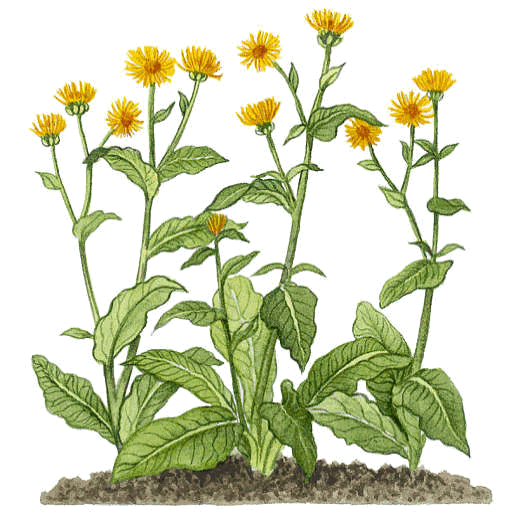Elecampane
Other Names: Alant, Aster helenium, Aster officinalis, Aunée, Elfdock, Elfwort, Helenio, Helenium grandiflorum, Horse-Elder, Horseheal, Indian Elecampane, Inula, Inula helenium, Scabwort, Velvet Dock, Wild Sunflower, Yellow Starwort.

There is a legend that tells how the name inula comes from Helen of Troy, whose tears turned into the healing plant known as elecampane.
Special Precautions of Elecampane
Although elecampane is considered a valuable herbal remedy for many conditions, occasional allergic reactions may occur. Inula helenium should not be used during pregnancy. Always inform your health care professional of any medications, vitamins or herbs that you are taking, and find a reputable source to ensure that your supplements are high quality.
The benefits of Elecampane are
Elecampane constituents are inulin, mucilage, volatile oil (helenin, camphor, alantol), alantoic acid, a thymol derivative, sesquiterpene lactones (including alantolactone, isoalantolactone), triterpenoid saponins, sterols, and bitter principles (possibly including dammaradienol, stigmasterol, friedlin), resin, pectin, and possible alkaloid.
- Its actions are expectorant, anti-tussive, sedative, anthelmintic, diaphoretic, stomachic, antifungal, antiparasitic, relaxant, warming, tonic, alterative, diuretic and anti-bacterial.
- Ancient Greeks and Romans considered elecampane as a cure-all for a broad range of ailments; it was considered a useful herbal remedy for dropsy, digestive upsets, menstrual disorders and sciatica. Elecampane was used as an herbal cold remedy and it was believed to aid digestion and to promote sweating and bring up phlegm.
- The Anglo Saxons used elecampane as a tonic and as a treatment for many skin diseases and leprosy.
- In the 19th century, the elecampane roots were used to prepare cough drops, asthma lozenges and candy.
- Medieval herbalists used elecampane as the main ingredient in a digestive wine called “potio Paulina” after St. Paul’s suggestion to use a little wine for the stomach’s sake.
- Elecampane has a long history in veterinary medicine as an effective remedy for skin diseases of sheep and horses. The veterinary use of elecampane is the origin of the herb’s other names, scabwort and horseheal.
- Elecampane was once listed in the U.S. Pharmacopeia, and has been long valued as a tonic herb for the respiratory system. It was used traditionally as a specific remedy for chronic bronchitis and bronchial asthma. It was thought to soothe the bronchial tube linings and act as an expectorant. Inula helenium is believed to be useful in any respiratory condition which produces copious mucus discharge and it is specifically indicated in the irritating cough of bronchitis, especially in children.
- Inula helenium was traditionally used to treat the cough of pulmonary tuberculosis. Research has shown that the volatile oil is active against the tubercle bacillus. The volatile oil stimulates the mucociliary escalator and circulation, while the saponins stimulate the removal of mucus from the lungs.
- The constituents alatolactone and other related compounds have expectorant, secretolytic and antitussive actions; these have also demonstrated antibacterial and antifungal qualities.
- For the treatment of respiratory problems, elecampane combines well with marribium, tussilago, asclepias and achillea.
- It is a traditional remedy for worms; the constituent alantolactone has been used as an anthelmintic in the treatment of roundworm, threadworm, hookworm and whipworm infestation.
- Chinese research has demonstrated a mild antibacterial action of elecampane as well as a stimulating effect on the nervous system, digestion and adrenal cortex.
- as a flavoring agent in digestive liqueurs and vermuoths, it is used in candy and is often added to cough linctuses and pastilles.
- Inulin appears to lower the risk of Colon Cancer, of course more research needs to be done. Please do not confuse Inulin with Insulin for they are two different things.